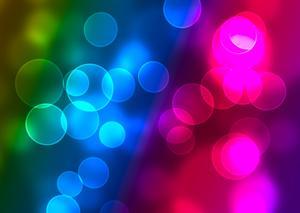| Complexity level: | 4 |
| Project cost ($): | 20 |
| Time required: | 2 hours to prepare, 1 day for observation |
| Material availability: | Easily found |
| Safety concerns: | NA |
Hypothesis
Persons who have been exposed to warm colors such as yellow or red will have increased blood pressure compared to persons who have been exposed to cooler colors such as green or blue.
Overview
Colors and mood
The influence of color on a person mood and consequentially their blood pressure, is determined by their psychological and cultural background. The behavior or emotions commonly associated with some colors are listed below. Such associations are based on cultural beliefs and are not necessarily based on scientific truths.
Blue is a cool color. It is calming and soothing to a person. It makes a person confident and secure.
Red is a warm color. It is known to increase a person heart beat rate and blood pressure. This color also represents passion, strength and danger.
Black represents elegance and class. This color has long been associated with death in many cultures. In such cultures, black represents emptiness and darkness.
White is the color of purity and peace. This color also represents cleanliness and sterility.
Green is also a cool color. It helps to keep a person calm. This color represents nature and intelligence.
Yellow is a warm color representing sunshine and happiness. However yellow has been known to also invoke anger.
Scientific Terms
Materials
The materials required for the experiment:
- 1 computer
- 10 male and 10 female participants of the same age
- Portable (wrist) blood pressure monitor
Procedure
- For this experiment, the independent variable is the color displayed on the computer screen. The dependent variable is the blood pressure of the participating individuals. This is determined by using the portable wrist blood pressure monitor. The constants (control variables) are the rest period in between viewing the monitor and length of time viewing the monitor.
- The computer is programmed to show screens of blue, red, black, white, green and yellow. You can set this up by using software such as Microsoft Powerpoint.
- The participants are brought into the room and allowed to relax. All their blood pressure readings are taken and recorded after 30 minutes.
- The 1st participant is seated in a comfortable chair in front of the computer monitor. The computer screen is set to blue color. The participant is asked to stare at the monitor screen for 3 minutes. After 3 minutes, the participant blood pressure is measured.
- The 1st participant is allowed to rest for 15 minutes before procedure 2 is repeated with the screen set to red, black, white, green and then yellow. All of the measurements are recorded.
- Procedure 4 and 5 are repeated with the remaining 19 participants and their blood pressure readings are recorded in the table below.

Results
You should observe that the participants' blood pressure increases after they have been made to stare at the red and yellow screens. Other colors do not lead to significant changes in blood pressure.
| Participant | Starting blood pressure | Blood pressure after staring at screen | |||||
| Blue | Red | Black | White | Green | Yellow | ||
| Male 1 | 95 | 97 | 106 | 98 | 96 | 95 | 104 |
| Male 2 | 100 | 103 | 110 | 103 | 102 | 102 | 108 |
| Male 3 | 102 | 102 | 115 | 104 | 103 | 104 | 114 |
| Male 4 | 98 | 98 | 110 | 100 | 99 | 100 | 108 |
| Male 5 | 110 | 110 | 120 | 112 | 112 | 110 | 116 |
| Male 6 | 112 | 114 | 122 | 113 | 112 | 112 | 120 |
| Male 7 | 108 | 109 | 118 | 110 | 108 | 108 | 116 |
| Male 8 | 98 | 98 | 110 | 99 | 100 | 98 | 108 |
| Male 9 | 100 | 103 | 108 | 102 | 102 | 102 | 108 |
| Male 10 | 97 | 98 | 106 | 98 | 98 | 96 | 105 |
| Female 1 | 93 | 95 | 105 | 95 | 95 | 95 | 104 |
| Female 2 | 94 | 94 | 102 | 95 | 96 | 95 | 100 |
| Female 3 | 98 | 100 | 108 | 102 | 100 | 100 | 107 |
| Female 4 | 102 | 102 | 112 | 100 | 101 | 102 | 111 |
| Female 5 | 92 | 94 | 103 | 95 | 96 | 95 | 102 |
| Female 6 | 95 | 96 | 105 | 97 | 96 | 95 | 104 |
| Female 7 | 105 | 107 | 115 | 106 | 105 | 104 | 112 |
| Female 8 | 98 | 98 | 106 | 100 | 99 | 98 | 105 |
| Female 9 | 100 | 100 | 112 | 98 | 102 | 101 | 110 |
| Female 10 | 102 | 104 | 115 | 104 | 105 | 103 | 113 |
Conclusion
The hypothesis that the colors red and yellow will cause a person's blood pressure to rise, is proven to be true. The calmer colors of blue and green, and the neutral colors of white and black did not show any significant effect on blood pressure.
The color of the environment that we live in might have a significant effect on our moods and health. This field of study may also be useful in the advertising industry, where colors are used to create specific moods.
Also consider
The experiment can also be performed using different colored light bulbs to light up the room and to check blood pressure.
Another alternative, would be to check the pulse rate instead of blood pressure.
References
- http://en.wikipedia.org/wiki/Color_symbolism_and_psychology
- Relationship between Color and Emotion: A study of College Students - Nazi Kayak, Helen H. Epps: College Student Journal, Vol. 38, 2004

